January 14, 2013 Saurabh Joshi - stratpost.co
StratPost was invited to visited Airbus Military facilities at Getafe in Spain last week to get a sense of the aircraft acquisition under consideration by the IAF, after the A-330 MRTT
was announced as the preferred bid in the refueler competition. Here's a look at what goes into the aircraft.
The selection of the Airbus A-330 MRTT (Multi Role Tanker Transport) aircraft as the preferred L1 bid in the Indian Air Force (IAF) competition for refuelers over the Russian IL-78 was confirmed
last week by Airbus.
![A British Royal Air Force Airbus A-330 MRTT at the Singapore Air Show in February 2012 | Photo: StratPost [Click to enlarge]](http://www.stratpost.com/wp-content/uploads/2012/04/mrtt3-600-x-244-150x61.jpg)
A British Royal Air Force Airbus A-330 MRTT at the Singapore Air Show in February 2012 | Photo: StratPost [Click to enlarge]
This was the second time the tender for
six refuelers was played out, with the first
one having been canceled after the finance ministry objected to the air force selection of the Airbus A-330 MRTT in 2010, on the ground of being more expensive than the IL-78, which was also
already in operation in the IAF. Life Cycle Cost, which appears to have swung the current tender in favor of Airbus, was not a
factor the last time around.
StratPost was invited to visited Airbus Military facilities at Getafe in Spain last week to get a sense of the aircraft acquisition under consideration by the IAF.
The Airbus A-330 MRTT is based on the civilian A-330 airliner, which after manufacture is converted to the military MRTT variant.
Antonio Caramazana, Head of Airbus Military Derivatives which includes the Airbus military tanker line, explained the scope of the conversion of the civilian airliner to the military variant.
“The first step is to construct the green aircraft. The construction of the green aircraft is identical to the construction of any other green aircraft that we do at Airbus in Toulouse.”
Toulouse is where all the various large parts for the A-330 and A-340 manufactured at various places are put together in the final assembly line over a period of ’61-62 days’. “All these are
assembled all together and we’ve got a green aircraft. So the green aircraft at that point in time are identical to any other green aircraft of any airline – Air India or any other airline,”
explains Caramazana.
The green aircraft are brought with a full seat configuration to Getafe in Spain, where they are converted to the military variant at one of three conversion sites over a period of one year. The
tanks are part of the wings from the very beginning and their capacity is 111 tons, toting up to 140,000 liters of fuel. Caramazana says the military modification includes structural
modifications to the wings besides other parts of the aircraft, installation of the pods, FRU (the basic air-to-air refueling systems) along with military avionics, military communication and
navigation kit. Airbus also modifies the green aircraft computers to complete the integration of the civilian avionics with military avionics, in addition to modifications to the cargo bays to
enable the carriage of military pallets.
![Various configurations of the Airbus A-330 MRTT | Photo: Airbus Military [Click to enlarge]](http://www.stratpost.com/wp-content/uploads/2012/04/mrtt1-600-x-319-150x79.jpg)
Various configurations of the Airbus A-330 MRTT | Photo: Airbus Military [Click to enlarge]
While Boeing has a common assembly line for both civilian and military variants of its 737 (like the P-8), wherein a military aircraft is produced in the same assembly line and then simply
diverted to a military configuration assembly line, Airbus does it differently.
Caramazana says there’s a good reason why they bring a complete aircraft from Toulouse and strip it down to convert it into the military variant. Airbus manufactures around a 100 aircraft a year
at Toulouse. After a series of analyses conducted when Airbus was preparing its proposal for the UK and competing in the US tender for refuelers, the company concluded that disruption of the final assembly line at Toulouse, to
accommodate the introduction of the features of the military variant at Toulouse itself, would be costlier and more time-consuming.
“To do one aircraft with a complete different configuration – at the end – even though it looks like it is easier or cheaper to do it that way – at the end to disturb the final assembly line of
Airbus will disturb more than for us to remove the seats. In fact to remove and prepare the aircraft it takes us three weeks. And it is cheaper,” he says.
![Cutaway of the Airbus A-330 MRTT | Photo: Airbus Military [Click to enlarge]](http://www.stratpost.com/wp-content/uploads/2012/04/mrtt2-600-x-317-150x79.jpg)
Cutaway of the Airbus A-330 MRTT | Photo: Airbus Military [Click to enlarge]
He also points out that the aircraft requires extensive modification after being stripped of all the seats and panels as its roles include not only passenger and cargo transport but also
air-to-air refueling and aeromed functions, which would be highly disruptive to the assembly line at Toulouse. “We are touching almost every system of the aircraft,” says Caramazana, including as
examples, the addition of around 600 harnesses, from the avionics bay and cockpit down to the FRU, introduction of 22 to 25 military antennae for communication and navigation, conversion of the
cargo bay to carry military pallets with a capacity of 45 tons, and enabling the removal of seats from the main cabin for the installation of medical beds.
“To facilitate all these operations we’ve got to remove all the panels of the aircraft so we have to strip down the aircraft in order to get access – to do all the structural, electrical and
systems modifications for implementing the military avionics,” says Caramazana.
Systems impacted include the electrical system, avionic systems, communication systems, electronic display systems, hydraulic systems. “The modification is intense,” he says.
![British Royal Air Force Airbus A-330 MRTT at Leh | Photo: Airbus Military [Click to enlarge]](http://www.stratpost.com/wp-content/uploads/2013/01/14.-A330-MRTT-RAF-600-x-400-150x100.jpg)
British Royal Air Force Airbus A-330 MRTT at Leh | Photo: Airbus Military [Click to enlarge]
Airbus Military had brought the UK Future Strategic Tanker Aircraft (FSTA) A-330 MRTT to India for trials in November, 2011, which included a deployment at Leh and refueled Sukhoi-30 MKI,
Mirage-2000 and Jaguar aircraft of the IAF.
The IAF, says Caramazana, has asked for some significant customization.
The IAF A-330 MRTT will have 291 seats. It will also be required to have differentiated fuel tanks which will allow the aircraft to carry two different types of fuel.
“Russian planes use different fuel,” he says, “And western planes have been qualified for a different fuel. So you operate aircraft with western fuel and (other) aircraft – Sukhoi 30 – with
Russian fuel. And in this sense we are going to isolate one of the tanks in order to provide this capability. You’ve got a mix of aircraft so you have to have the capability to load Russian fuel
in a particular tank and the other fuel in other tanks.” For this he says, the central tank will be differentiated to carry Russian fuel ‘in order to provide different fuels for the FRU. Fuel for
aircraft of western origin will be carried on the wing tanks.
“The other modification is we’ve been requested to install a Defensive Aids System, a radar warning receiver and a chaff and flare dispenser system,” says Caramazana, adding that the avionics,
manufactured by Thales, will also undergo some customization as per Indian requirements.
One issue that he says requires a decision ‘as soon as possible’ is the selection of the engines for the aircraft. “We’ve got a choice for the customer to select the GE or Rolls Royce (engines),”
adding further, “It is one of the decisions that we’ve got to take immediately during contract negotiations because this lays down the production of the green aircraft and as well as the
interfaces for the systems, so we’ve got to select the FMS for one engine or the other engine. So the selection of the engine is critical for maintaining the schedule. And this will be one of the
points that have to be decided during contract negotiations – the sooner the better.”
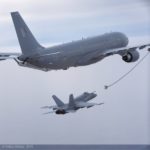
The Hose and Drogue refueling system onboard the Airbus A-330 MRTT | Photo: Airbus Military
Ian Elliot, vice president at Airbus Military explains the two types of refueling concepts available. Hose and drogue (also known as probe and drogue) and boom refueling.
In the first system, rubber hoses that can be up to 90 feet long are extended from the pods under the wings and an optional center-line air refueling unit with drogue that ‘looks like a shuttle
cock at the end’. “The hard work is done by the receiver airplane. So if I’m sitting there in my Rafale and if I want to come up behind and get some fuel, I can either do this by talking to him
on the radio or there are procedures where I can do the whole thing silently,” says Elliot, adding, “When the tanker’s ready he will either give us a radio signal or a light signal to allow us to
move behind the hose pipes. The fighter pilot has to line up some markings and when you’re happy, you power up the engines a little bit and you approach the tanker at a ‘fast walk walking pace’.
With the fighter moving faster than the tanker, the probe extended by the fighter enters the drogue and clips lock it in place, allowing the fuel to flow.
However, this system provides a lower rate of fuel flow of 420 gallons or 1.2 tons per minute from the pods and 600 gallons or 1.8 tons per minute from the center-line FRU. The boom system can
deliver 1,200 gallons per minute.
Jesús Lapastora Turpin, the Head of AAR Engineering Simulation, which includes the A330 MRTT engineering simulator describes how the aircraft manages to maintain its balance in the air with the
changing center of gravity while offloading fuel to receiver aircraft. “What we do is we modify the fuel system. The fuel system has two computers. And the center of gravity is maintained by
those computers. So if the fuel computers knows the quantities of all the tankers and knows the quantities you are deploying – it even takes into account the actual offloads you have delivered to
each of the receivers. And it manages to get the aircraft balanced. If the computers fail you also have a manual system,” he says, which is operated by the pilots.
Since the fuel used by the aircraft is common with the fuel dispensed to receiver aircraft, maximum fuel offload capability has to be calculated on the fly. “The same tanks are used for refueling
as well as consumption by the aircraft, so there has to be a constant trade-off,” says Turpin, adding that that the limit for the maximum fuel that can be delivered is stipulated. “Apart from
that limit you cannot deploy more fuel for the plan that you are going to do, so that you have enough fuel to go to your destination airport. But the computer is always computing that margin.”
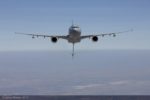
An Airbus A-330 MRTT with boom refueler extended | Photo: Airbus Military
The boom system incorporates a large metal telescopic pipe, or boom, with flying surfaces at the end which is extended by the refueling operator, who uses a joystick to drive the end of it into
the receiver airplane. “So if you want to get a lot of fuel into an airplane, boom is the way to get it. The problem is you can only do one airplane at a time,” says Elliot, who also clarifies,
“The Indian Air Force required it to have wing refueling pods and a center-line hose and drogue. There is no Indian Air Force requirement for a boom.”
He also points out, “Your air force is interesting because your air force will have some airplanes that can only be refueled by a boom. I’m thinking of your C-17s and your P-8s.” The IAF C-17
and Indian Navy’s P-8I aircraft, both manufactured by Boeing, can only be refueled by the boom system. “You will have some boom receivers but no boom tankers,” he says.
Caramazana says other IAF aircraft like the ‘Sukhoi, Jaguar, Mirage-2000 and now Rafale’ are all hose and drogue receiver aircraft.
While so far, these aircraft were only refueled by IL-78 aircraft, already in service in the IAF, he says the Airbus A-330 MRTT offers significant advantages over the Russian tanker, with a
higher fuel capacity, passenger capacity and cargo capacity. “You can deliver more fuel to the receivers and therefore you have longer reach for the receivers,” he says, also stating “The Russian
is designed – the cost of maintaining and operating the aircraft is tremendous and the fuel consumption compared to this one (A-330 MRTT) is double. The actual figure I cannot tell you, but it
consumes much, much more.”
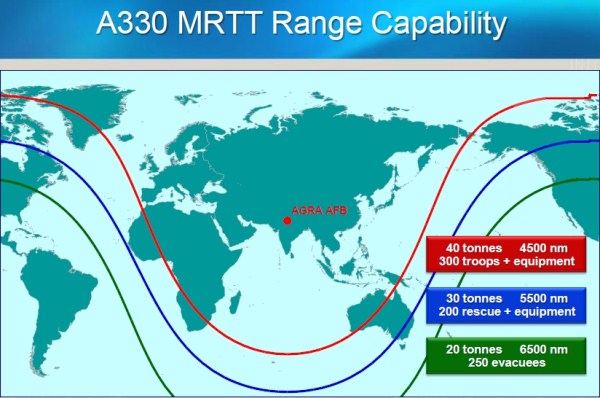
Estimated range of the Airbus A-330 MRTT | Photo: Airbus Military
He also says that the cost of operation and maintenance is significantly cheaper and more efficient with the latest design of the MRTT. Caramazana also points to the widespread and worldwide
operation of the A-330, saying it brings other advantages as well. “Now we are working with serial number 1390 – that is the latest that we are going to receive – so we’ve got 1,500 – in four or
five years time you will have 2,000 A-330s flying everywhere in the world,” and training, support and spares for the aircraft are available globally, an advantage that he says the Ilyushin does
not offer.
Caramazana also says that maintenance of the aircraft, its engines and landing gear is common with A-330 civilian airliners, which has only to be supplemented with maintenance of the onboard
military equipment.
Upon signature of the contract, if and when it is concluded, Airbus will be required to deliver the first aircraft within 36 months hence, followed by a delivery of subsequent aircraft every
three months, ending with final delivery within 51 months from the conclusion of the contract.
The cost of this acquisition is speculated to range from INR 8,000 crore (INR 80 billion) to INR 12,000 crore (INR 120 billion). What is clear is that there will be a significant increase in the
price quoted by Airbus in the first tender, which it won before it was canceled.
Caramazana says the cost of inflation alone would be three to four percent per year or nine to ten percent in the three years since the cancellation.
Incidentally, if inducted, this would be the first time the IAF would have an Airbus aircraft in its fleet
















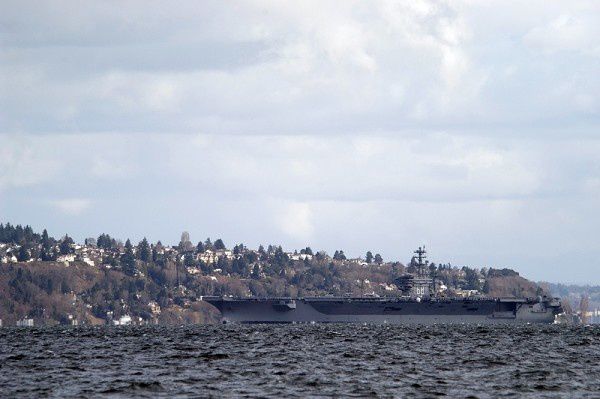


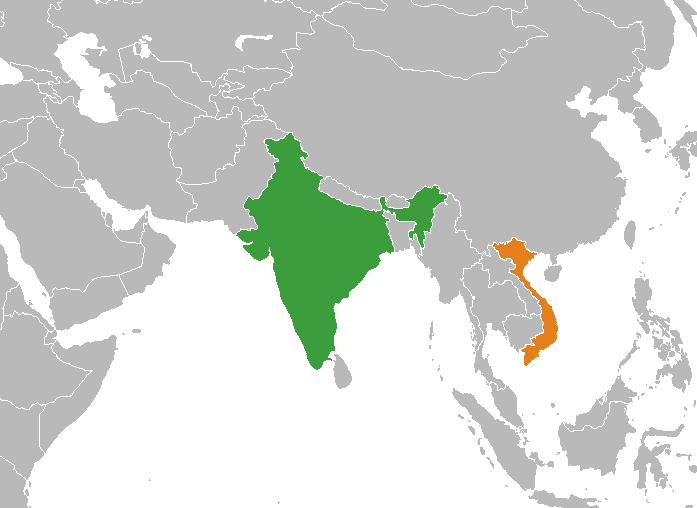
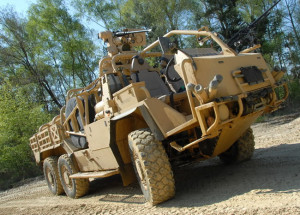

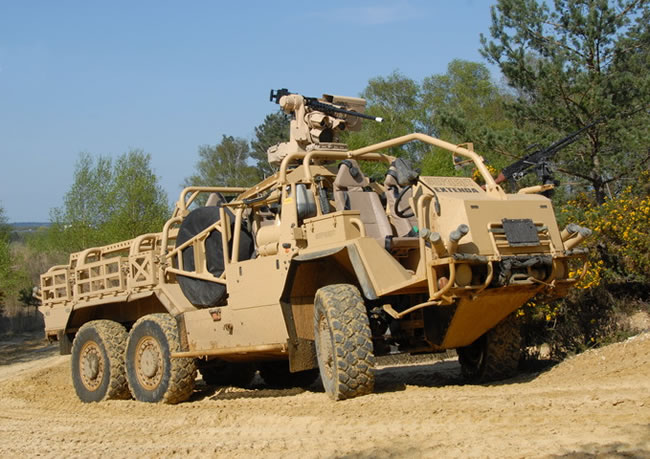

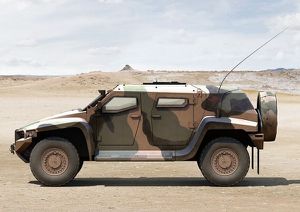
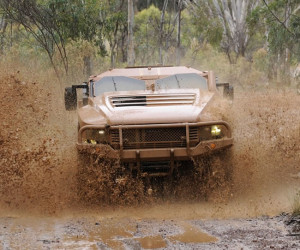
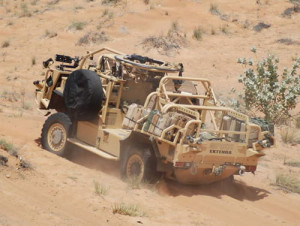



![A British Royal Air Force Airbus A-330 MRTT at the Singapore Air Show in February 2012 | Photo: StratPost [Click to enlarge]](http://www.stratpost.com/wp-content/uploads/2012/04/mrtt3-600-x-244-150x61.jpg)
![Various configurations of the Airbus A-330 MRTT | Photo: Airbus Military [Click to enlarge]](http://www.stratpost.com/wp-content/uploads/2012/04/mrtt1-600-x-319-150x79.jpg)
![Cutaway of the Airbus A-330 MRTT | Photo: Airbus Military [Click to enlarge]](http://www.stratpost.com/wp-content/uploads/2012/04/mrtt2-600-x-317-150x79.jpg)
![British Royal Air Force Airbus A-330 MRTT at Leh | Photo: Airbus Military [Click to enlarge]](http://www.stratpost.com/wp-content/uploads/2013/01/14.-A330-MRTT-RAF-600-x-400-150x100.jpg)



